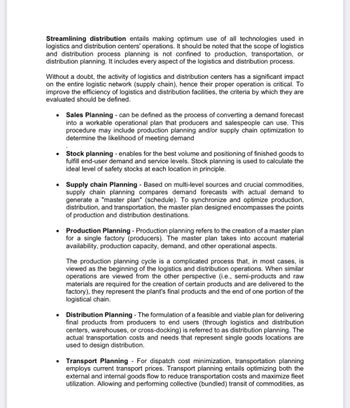
Understanding Business
12th Edition
ISBN: 9781259929434
Author: William Nickels
Publisher: McGraw-Hill Education
expand_more
expand_more
format_list_bulleted
Question
Explain the impact of streamlined distribution in different networks. (Please refer to the given lesson)

Transcribed Image Text:Streamlining distribution entails making optimum use of all technologies used in
logistics and distribution centers' operations. It should be noted that the scope of logistics
and distribution process planning is not confined to production, transportation, or
distribution planning. It includes every aspect of the logistics and distribution process.
Without a doubt, the activity of logistics and distribution centers has a significant impact
on the entire logistic network (supply chain), hence their proper operation is critical. To
improve the efficiency of logistics and distribution facilities, the criteria by which they are
evaluated should be defined.
●
Sales Planning - can be defined as the process of converting a demand forecast
into a workable operational plan that producers and salespeople can use. This
procedure may include production planning and/or supply chain optimization to
determine the likelihood of meeting demand
Stock planning - enables for the best volume and positioning of finished goods to
fulfill end-user demand and service levels. Stock planning is used to calculate the
ideal level of safety stocks at each location in principle.
• Supply chain Planning - Based on multi-level sources and crucial commodities,
supply chain planning compares demand forecasts with actual demand to
generate a "master plan" (schedule). To synchronize and optimize production,
distribution, and transportation, the master plan designed encompasses the points
of production and distribution destinations.
Production Planning - Production planning refers to the creation of a master plan
for a single factory (producers). The master plan takes into account material
availability, production capacity, demand, and other operational aspects.
The production planning cycle is a complicated process that, in most cases, is
viewed as the beginning of the logistics and distribution operations. When similar
operations are viewed from the other perspective (i.e., semi-products and raw
materials are required for the creation of certain products and are delivered to the
factory), they represent the plant's final products and the end of one portion of the
logistical chain.
Distribution Planning - The formulation of a feasible and viable plan for delivering
final products from producers to end users (through logistics and distribution
centers, warehouses, or cross-docking) is referred to as distribution planning. The
actual transportation costs and needs that represent single goods locations are
used to design distribution.
Transport Planning - For dispatch cost minimization, transportation planning
employs current transport prices. Transport planning entails optimizing both the
external and internal goods flow to reduce transportation costs and maximize fleet
utilization. Allowing and performing collective (bundled) transit of commodities, as
Expert Solution
This question has been solved!
Explore an expertly crafted, step-by-step solution for a thorough understanding of key concepts.
Step by stepSolved in 2 steps

Knowledge Booster
Similar questions
- analyze how digital channels and traditional channels can complement each other in a comprehensive marketing strategy, analyzing integrated marketing campaigns that effectively combine both digital and traditional elements.arrow_forwardExamine the development of e-commerce, digital marketing platforms and channels in comparison to physical channels.arrow_forwardfuture technology related to distribution businessarrow_forward
- One disadvantage of direct-to-customer channels is that Multiple Choice most organizational buyers are used to relying on intermediaries to serve as their purchasing advisors. they require producers to shift many marketing functions to others. this approach makes it hard to achieve coordination among the required marketing activities. they make it more difficult to get information about changing needs of the market. None of the answers are correct.arrow_forwardWhat are some of Vivobarefoot's competitive advantages as a result of its infrastructure upgrade?arrow_forwardHow are nontraditional channels of distribution affecting your organization and its marketing strategy? Appraise the situation and discuss.arrow_forward
arrow_back_ios
arrow_forward_ios
Recommended textbooks for you
 Understanding BusinessManagementISBN:9781259929434Author:William NickelsPublisher:McGraw-Hill Education
Understanding BusinessManagementISBN:9781259929434Author:William NickelsPublisher:McGraw-Hill Education Management (14th Edition)ManagementISBN:9780134527604Author:Stephen P. Robbins, Mary A. CoulterPublisher:PEARSON
Management (14th Edition)ManagementISBN:9780134527604Author:Stephen P. Robbins, Mary A. CoulterPublisher:PEARSON Spreadsheet Modeling & Decision Analysis: A Pract...ManagementISBN:9781305947412Author:Cliff RagsdalePublisher:Cengage Learning
Spreadsheet Modeling & Decision Analysis: A Pract...ManagementISBN:9781305947412Author:Cliff RagsdalePublisher:Cengage Learning Management Information Systems: Managing The Digi...ManagementISBN:9780135191798Author:Kenneth C. Laudon, Jane P. LaudonPublisher:PEARSON
Management Information Systems: Managing The Digi...ManagementISBN:9780135191798Author:Kenneth C. Laudon, Jane P. LaudonPublisher:PEARSON Business Essentials (12th Edition) (What's New in...ManagementISBN:9780134728391Author:Ronald J. Ebert, Ricky W. GriffinPublisher:PEARSON
Business Essentials (12th Edition) (What's New in...ManagementISBN:9780134728391Author:Ronald J. Ebert, Ricky W. GriffinPublisher:PEARSON Fundamentals of Management (10th Edition)ManagementISBN:9780134237473Author:Stephen P. Robbins, Mary A. Coulter, David A. De CenzoPublisher:PEARSON
Fundamentals of Management (10th Edition)ManagementISBN:9780134237473Author:Stephen P. Robbins, Mary A. Coulter, David A. De CenzoPublisher:PEARSON

Understanding Business
Management
ISBN:9781259929434
Author:William Nickels
Publisher:McGraw-Hill Education

Management (14th Edition)
Management
ISBN:9780134527604
Author:Stephen P. Robbins, Mary A. Coulter
Publisher:PEARSON

Spreadsheet Modeling & Decision Analysis: A Pract...
Management
ISBN:9781305947412
Author:Cliff Ragsdale
Publisher:Cengage Learning

Management Information Systems: Managing The Digi...
Management
ISBN:9780135191798
Author:Kenneth C. Laudon, Jane P. Laudon
Publisher:PEARSON

Business Essentials (12th Edition) (What's New in...
Management
ISBN:9780134728391
Author:Ronald J. Ebert, Ricky W. Griffin
Publisher:PEARSON

Fundamentals of Management (10th Edition)
Management
ISBN:9780134237473
Author:Stephen P. Robbins, Mary A. Coulter, David A. De Cenzo
Publisher:PEARSON